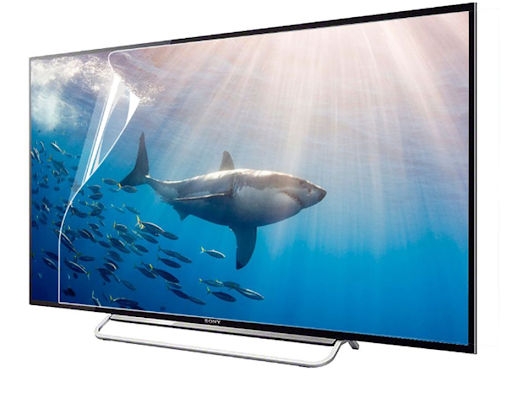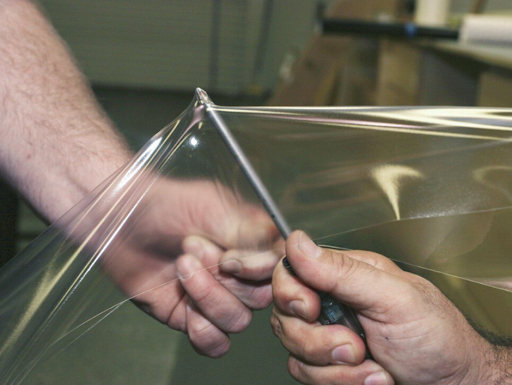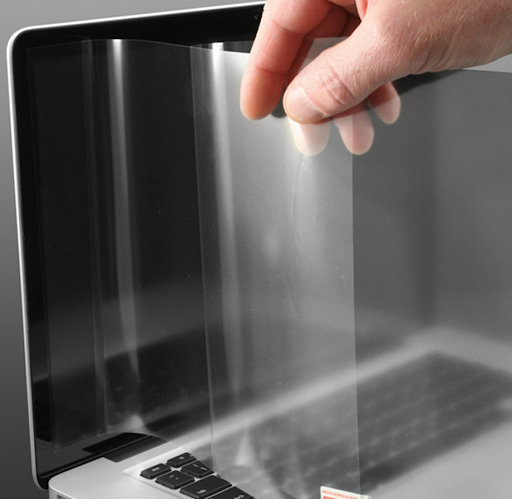
Protective films should be removed or they can pose a threat to your screen
Protective film for TV screens, monitors and many other electronic screens is always one of the minimum requirements of a reputable and quality product. Protective film helps preserve the newness of the product, eliminating factors that cause scratches and damage to the screen. However, protective films should be removed before use as they can pose a threat to your screen. The following article will help readers learn in more detail the role, operations and safe removal process of protective film today to protect your device. These notes will help protective film work most effectively and wonderfully!
1. What does the protective film do in TVs and monitors?

The protective film is only used in the process of displaying or transporting
Protective film is one of the most popular measures to protect screens and television screens. Protective film was designed and first introduced to the market in 1968. The main materials of Protective film are plastics such as polyurethane (TPU), polyethylene terephthalate (PET),... Protective film for the screen is usually about 0.1 mm and usually appears as a thin layer with a glossy or matte surface.
The main use of protective film is to protect the screen from external influences such as impact, scratches, water or dust. These external influences may damage or reduce the quality of the screen. That's why the screens of televisions, monitors or many other electronic devices are covered with a protective film. Carefully applying a protective film to the screen will bring significant benefits to the product.
The screen is an important part, determining the image quality that the TV or monitor brings to consumers. In case the screen is scratched or has color noise, it can bring a bad user experience and lose the value of the product. Protective film will always be prepared by the manufacturer to ensure newness and prevent dust and moisture during product display. Another use of the protective film is to help protect the screen during transportation, helping to minimize unnecessary scratches. However, according to production goals, the protective film is only used in the process of displaying products or transporting them to consumers. When putting the machine into use, removing the protective film is extremely necessary
2. Why does the protective film have to be removed?

Protective film is designed as a thin film that is usually transparent or slightly translucent
Protective film is necessary, but protective film needs to be carefully removed when the device is put into use. Most people will wonder whether protective film should be removed from TV screens or monitors. The reason is that protective film is designed as a thin film that is usually transparent or slightly translucent and is compatible with all screen resolution options. Because of this design, when first using the device, consumers will still feel the authenticity and bright colors of the image from the screen, even though they are looking through the protective film layer. This is also the reason why many people skip the step of removing protective film from TV screens or monitors.
The truth is that protective film is only effective when the product is not yet in use. If you leave the screen on for a few days without removing the protective film, it can be counterproductive. The main reason is that during use, the device screen will tend to gradually heat up, generating heat on the surface of the film. In fact, protective film is just a thin layer of plastic and if exposed to heat, it can melt or stick tightly to the screen. If this happens, the TV screen or monitors can easily be damaged or it may even be impossible to remove the protective film. Therefore, removing protective film at the right time is really important.
3. How to remove the protective film
Protective film won't come off and will need to be removed by humans. The protective film removal process also requires many important notes. When removing, it is necessary to determine the exact position of the protective film so as not to confuse it with the screen's polarizing plate. Confusing between protective film and polarized screen can cause serious damage to your screen and not qualify for warranty. Below are detailed instructions on the process of removing protective film for TV screens and monitors:

Protective film won't come off and will need to be removed by humans
Look closely at the device screen to make sure protective film exists on them to avoid accidentally removing the main screen. Some brands will design a small tab on the edge of the screen to mark the removal location. If they were more careful, they would design a few more stickers with messages encouraging the removal of protective film to help consumers pay more attention.
Place the device on a flat surface or in an easily fixed position to avoid falling during disassembly. It is also important to pay attention to the disassembly location and not be exposed to dusty environments because once it is covered in dust, it cannot be cleaned. For large devices, someone needs to assist in the process of removing the protective film so that the process goes smoothly because if you stop suddenly, it can leave marks on the screen.
- Step 3: Proceed to disassemble
Use your hand to slowly pull the tab to remove the protective film on the screen. At this step, be careful to remove it slowly and not too quickly to avoid causing ugly marks on your screen. Removing it at too fast a speed or with too much force can deform the polarizing layer of the screen. Note, absolutely do not use your fingernails to peel off the protective film because it may cause local screen damage. During the removal process, avoid touching the newly removed screen to avoid leaving fingerprints that will be difficult to remove later.
- Step 4: Stabilize the screen and use it
After removing the protective film for TV screens or monitors, let it stabilize for a few minutes before plugging in and using it. To avoid damage to the screen after removing the protective film, consumers can choose suitable cleaning products and soft towels. If not in use, you can cover it with a thin curtain
4. Conclusion
In general, protective film is very important in protecting TV screens, monitors or some other electronic device screens. Just a thin layer of TPU or PET, etc., can minimize the risk of scratches to the screen during display or long-distance transportation. However, when putting the product into use, consumers need to carefully remove the protective film to avoid damage to the screen when the temperature increases. In addition, when removing the protective film, consumers can enjoy the sharpest and most vivid image quality from the original screen.
5. About EuroPlas
EuroPlas will always be a great companion for your upcoming project. Our mission at EuroPlas is to constantly update and share useful materials knowledge with readers around the world. Visit the EuroPlas blog today to access a huge treasure trove of shared knowledge! We always have the criterion of providing customers with the most optimal material solutions in terms of both quality and price. In addition, EuroPlas provides a variety of typical materials such as biological fillers, bioplastics, colorants, additives and filler particles. You can find a variety of high quality and reliable options!